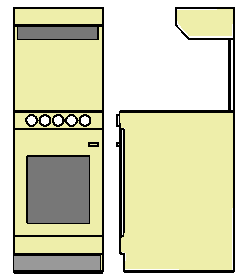Kitchen Equipment
From DT Online
Cookers, fridges, freezers,washing machines, dishwashers etc. are sometimes referred to as White Goods. - although coloured and stainless steel finishes are often preferred.
Most modern kitchen equipment can be free standing or built in. Decor panels are available to allow them to blend in with kitchen units.
Cookers can be split level with the oven set into a housing unit but this reduces available workspace and built-under ovens are becoming more popular. Electric cookers require their own 30 Amp circuit. Separate hobs and ovens can be fed from the same circuit provided neither is more than 2 metres from the switch. Regulations require that all electrical work carried out in a kitchen must be certificated by a registered electrician. showing the work has been tested. This applies to the addition of any new sockets, lighting fixtures, extractor fans, cookers and many other electrical items. A kitchen is regarded as a “special” area due to the proximity of water to the electrical sockets.
If mains gas is available, use it for cooking as well as heating. If it’s not, consider an electric induction hob, which saves energy over a conventional electric or halogen hob.
All gas appliances must be installed by a Gas Safe registered plumber, who will then check the system and issue a certificate, otherwise house insurance and appliance guarantees may not be valid. A gas cooker may not be installed in a room which has a volume of less than 6 cubic metres. The room must also have adequate ventilation by means of an opening window or some equivalent. A electricity supply for lights and igniter is also required. This is usually fused at 3 Amp.
Washing machines and dishwashers are often plumbed in near the sink against an outside wall for convenience. Dishwashers and some washing machines need only a cold water supply others also require hot water. Look for A-rated (energy efficient) kitchen appliances They need plumbing into a waste pipe and an electricity supply.
